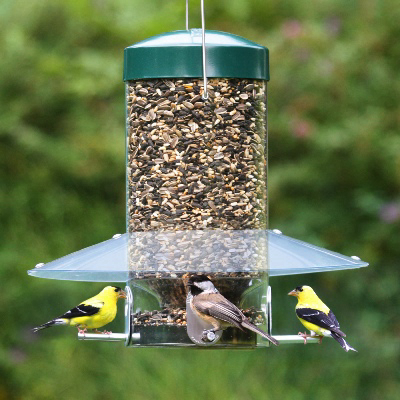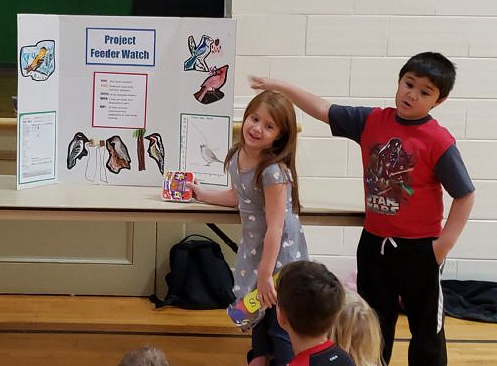

|
Every school should really have a bird feeding station, and now that students are settling into new classrooms and getting familiar with new teachers, it’s a great time to add a new dimension to their learning experience that will get them in touch with the nature that surrounds them. Birds are the best representatives of our natural world, and their active lives, attractive colors, varied sizes and shapes, and their ability to fly are all points of interest that attract us all. Birds are an excellent gateway to inspire learning about nature, nesting and migration behaviors, and the ecology of the world around us and far beyond.
What better way to bring birds into the lives of every student from pre-school thru college than to create a feeding station with a water feature outside a classroom window, or at a central location on the school grounds. The sudden appearance of one simple feeder to start with, a sunflower feeder or a thistle feeder will catch everyone’s attention; and a few days later, a hummingbird feeder or suet feeder will add another angle to feeding birds, and attracting different birds. Top it off with a birdbath with fresh water, and the following week you can add a small solar bubbler to add some action to the water, while progressively adding a little more interest among students.
Before long, a student or a number of classmates will probably become interested in helping to keep seeds, suet, and nectar stocked, along with fresh water. Everyone can help to keep a growing list of birds that visit the feeders and water feature, and a field guide to the birds in your area will be an important addition, even before the first feeder is introduced. Eventually, when students get familiar with area birds, a field guide to the birds of North America will pique their interest all the more.
Teachers can also develop bird-based projects that can be researched via the internet to create projects to learn more about certain species of birds. Just by accessing the “All About Birds” website, a student can access a wealth of information about any North American bird species and bird families. Students can also learn about feathers, anatomy, nesting, food types, migrations, and much more; and birds can be a focus of combining biology with geography, English, speech, creative writing, and other subjects.
Where to Begin
This initial effort may be most appropriate if led by a teacher, an instructor who is a birder, a science teacher, or a school administrator. But it can also be introduced by a parent or someone in the neighborhood who would like to add to the students’ experiences. In that case, it would require obtaining the cooperation and interest of a teacher or administrator in the school, and may even require that person – maybe you – to provide the initial feeders and birdbath, and some initial foods.
It may be a good idea to organize a funding method in advance, perhaps calling on a local birding group, Audubon chapter, or area businesses to provide a bit of financial support for a school or class feeding station. Eventually, students may become so enthused that they might hold a bake sale or car wash to raise money for a birding station – or even sell T-shirts. A good example of how some students have reacted to adding birds and bird feeding to their learning experience at school – from kindergarten to college – are some classes that participate in Project FeederWatch.
Project FeederWatch is a citizen-science project that offers a higher level of participation and interest, but it’s fun and easy. You simply identify and count all the birds that visit your feeder location – or any location – at certain periods during certain days. It may be an after-school effort by a dedicated group of students, but a worthy effort if there is an interest.
A Great Example
An elementary teacher, Kelly Zajac, and her students in Michigan relished participating in Project FeederWatch. Kelly explained that she began the program when it was recommended by a parent, and since then the project has been a great value to Kelly’s students and class overall, especially related to lessons regarding ecology and conservation. She said her students learn about the birds and that contributing to FeederWatch is a great way for students to feel like they are helping their local ecosystem and adding to the citizen-science project. The students look forward to reviewing information they record to see the pattern of changes in the variety and abundance of birds that visit their feeding station.
Kelly said, “Observing our local birds has taught us so much in a non-traditional way. We’re learning more.” Her class has several feeders to watch, all lined up in front of the school so other students and people in the neighborhood can view them too. Their set-up includes a suet feeder, seed tube feeders, seeds pressed into cylinders, and they also provide peanuts and dried fruit. Their feeders are hung from poles that are fitted with baffles to help prevent mammals, including squirrels and racoons, from accessing the bird food. Kelly reported the class sees a variety of birds: “We have seen finches, wrens, woodpeckers, chickadees, and more. Favorites are the species of woodpeckers, goldfinches, and wrens.”
As for tips for other teachers on how to get their students excited about birds, Kelly suggested letting the students take charge. “Give them bird identification books, let them sit near the feeders to wait for birds to come. Have students fill the feeders; have a knowledgeable birder or biologist give a presentation; and follow the students’ lead on their interests.” For more information from teachers and students participating in Project FeederWatch, you can refer to Posts – FeederWatch
Birds are an interesting and active group of animals that we see every day, and they can add to students’ learning experiences in a number of ways. A bird feeding station can be an inspiring and exciting addition outside any classroom window, or at a specially designated area in a schoolyard. For more information about basic bird feeding activities, feeders, and birdbaths, you can refer to Feeding Birds - FeederWatch
To learn more about Project FeederWatch, which traditionally begins November 1st and continues to April 30th, see How to Participate - FeederWatch But don’t wait until November, start creating your feeding station now to get practiced before getting involved with Project FeederWatch. Good luck and have fun!
Share your backyard and schoolyard birding experiences and photos with The Birding Wire at editorstbw2@gmail.com